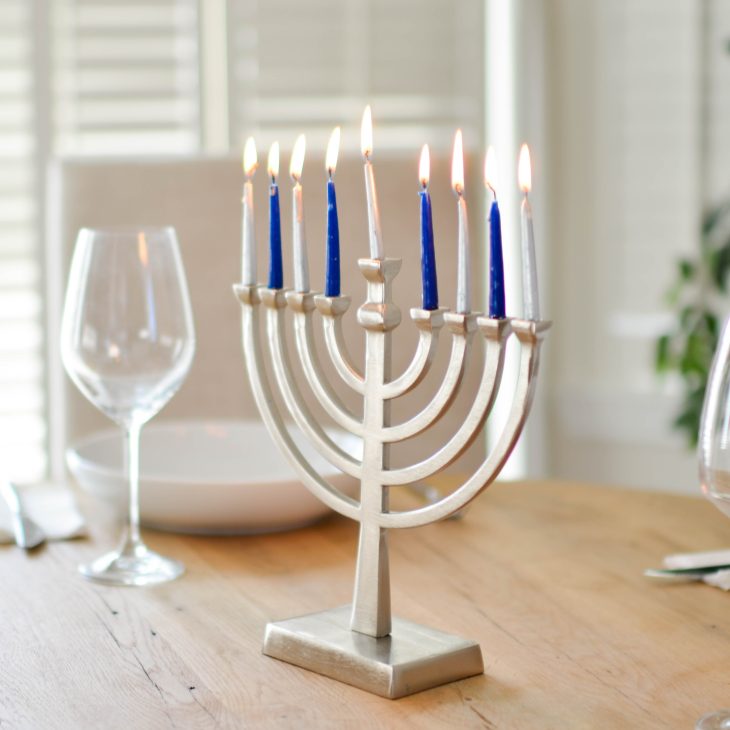Pirsumei Nisah and Hope During Hanukkah
December 15, 2020

One of my favorite paintings is Judith Slaying Holofernes, by Artemisia Gentileschi. The iconic painting depicts a Jewish woman beheading an Assyrian general with the can-do face of an ancient Rosie the Riveter. In the apocryphal Book of Judith, the Assyrian army has besieged the town of Bethulia, and the people have run out of food and water. Desperate, the leaders of the city are considering surrender when Judith, a beautiful widow, declares to the town elders that God has not forgotten them. She and her maidservant leave the town walls and enter the Assyrian camp, going straight to the general Holofernes where she ingratiates herself to him with an offer of intelligence. After spending several days in Holofernes’ camp, Judith feasts with him, plying him with wine until he passes out in a drunken stupor. Using his sword, she deftly cuts off his head, tosses it in her basket, and with her handmaid, returns to Bethulia. The Assyrian army, now with a headless leader, disperses in fear, and the Jewish people are saved.
This story has come to be associated with the story of Hanukkah, with the parallel names of Judith and Judah Maccabee (who are described by some as aunt and nephew) and the victory over an oppressive foreign regime. However, the story of Hanukkah does not appear in the Book of Judith, and it is not until the medieval period that commentators drew a connection between the two. In fact, there is no record of a town in Judea called Bethulia, and while the enemy nation in the Book of Judith is Assyrian, the king of the Assyrians is identified as the famous Babylonian King Nebuchadnezzar, while the evil general Holofernes has a Greek name (Simkovich). The story of Judith eschews any strict markers to time or place, making it a perennially meaningful tale. Judith brings hope to her people in a moment of absolute despondency, on the brink of starvation and annihilation. What messages of hope might her story offer our current moment?
During this year’s celebration of Hannukah, I am drawing upon sources of hope. Reflecting on where I can find wisdom around hope. I am looking towards other women who have guided me and helped me to grow through the years, whether that is through written words or in the classroom.
In Men in Dark Times, Hannah Arendt writes that illumination in the darkest of times “may well come less from theories and concepts than from the uncertain, flickering, and often weak light that some men and women, in their lives and in their works, will kindle…” I will be the first to admit that I often place my hope in ideas. My bookshelves team with my values and with my tradition, and it is on their shelves that I find my way through an articulation of the world I want to live in. Ideas are indeed powerful, for good or for evil, but it is within individuals that ideas are lived out, and in their works that the best ideas of our time are actualized. One of my teachers, Professor Ann Pellegrini, once said, “one of the modalities of hope is that we are likely to be disappointed. And rather than see disappointment as a reason not to hope, the fact that we’re likely to be disappointed might be a reason to hope even bigger and even better.” The way that we live out this hope is through our daily actions, bringing illumination into our lives and the lives of those around us. Hope is made manifest in the healthcare workers who save lives, in the scientists who create vaccines, the organizers on the front lines for racial justice, and the grassroots campaigners bringing new people into office. To hope is to take action even in the face of certain defeat, and it is in hope that salvation lies.
On Hanukkah, we have a mitzvah, a ritual obligation, of pirsumei nisah, publicizing the miracle of Hanukkah. (Whether that’s the miracle of a military victory or one of oil that burned for eight days is up for debate.) We place our menorah in our doorframes or in our windowsills, so that all who walk by our homes may know of our miracles and may benefit from our light. The menorah sits in this liminal space of our homes, between inside and out, between public and private. Rabbi Dr. Erin Leib Smokler writes that after six days of creation and before resting, God created liminality, space in-between evening and morning, the “unscripted and unbounded, surprising and awe-inspiring….[for] wondrous things emerge in the in-betweens—whimsy, beauty, oddity, revelation, creativity.” The in-betweens are where life takes place, made manifest even in the body, the meeting point between the self and the outside world – that liminal space where a singular identity constantly makes use of the senses to engage with surrounding society.
We have spent a year navigating the tension between inside and outside, between safety and danger, between private and public expressions of belief, grief, and hope. May Judith’s story of hope and action remind us of what is possible in the spaces of creativity and possibility that exist in each of our own lives.
Share
Related Articles
Racial Equity
A Year After George Floyd’s Murder: How Black Interfaith Can Give Hope to America
Interfaith Inspiration
Interfaith Inspiration



